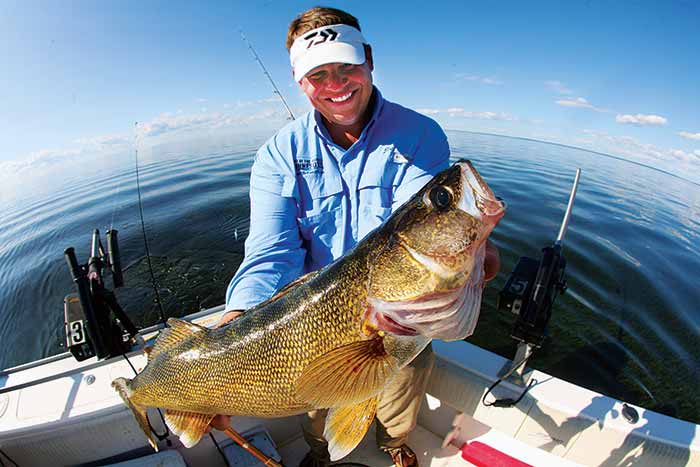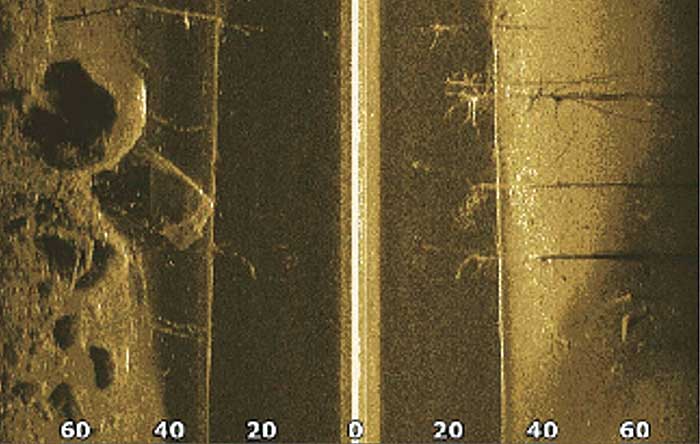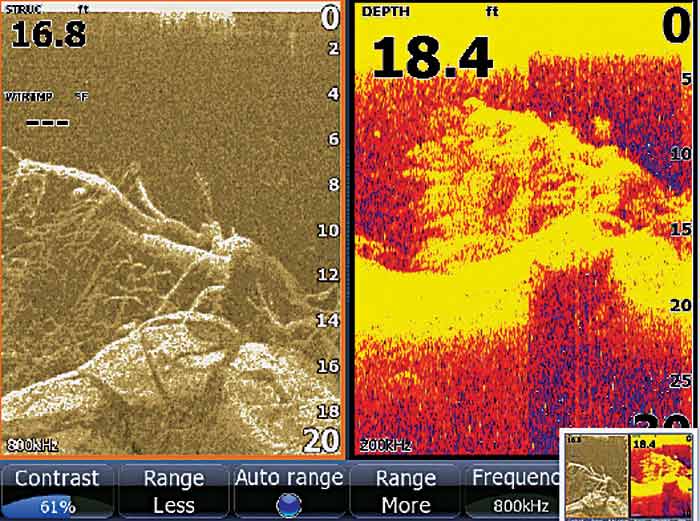Advertisement
Today's advancing technology gives you lots of amazing choices when it comes to how you'll find those fish.

Photo: Doug Stamm
These days, shopping for a new fishfinder is almost as complex as trying to understand a super computer. Maybe that's because compared to the fishfinders we were using just a few decades ago, today's units are super computers. What was once a few blinking lights on a dial has evolved to become an accurate screen-viewed image that's tack-sharp in detail, and in some cases, able to portray what lies as far as 10,000 feet below your boat's keel. If you're having trouble sorting it out, don't feel bad. The introduction of multiple new fishfinding technologies in a few short years has left the savviest sonar sharpies among us feeling as confused as a fish struggling against an invisible line. It's time to spread out the options at hand — standard sonar, imager/scanners, side-finders, and CHIRP — and make understanding fishfinders easy again.
Tip
Modern sonar screens allow you to spot the weight for your downriggers, letting you drop it to the same depth as the fish more easily.
Standard Sonar
Common fishfinders, which became popular in the '80s and ruled the '90s, utilized one or two beams in the neighborhood of 200 and/or 50 kHz to ping through the water column, and displayed the results on an LCD screen. Color became a popular option, and today all but the most basic fishfinders utilize color screens. "Hotter" colors such as red indicate stronger returns, and "cooler" colors such as yellow or green indicate weaker returns. You can get a color machine with a small screen for a few hundred dollars these days, and a high-end unit with a large screen for a couple of thousand. For all-around use in varying circumstances, these fishfinders rule. There's a reason the 200-kHz beam became a standard, and that reason is versatility. If you have one boat that gets used on the lake, the river, the bay, and the ocean, this kind of flexibility is exactly what you need.
Pros: The standard 200-kHz beam offers fair detail with good depth penetration, and the lower-frequency beam gives you the ability to extend range (at the cost of detail, of course). Differentiating fish from structure is relatively easy, and large fish create hot-red arches onscreen.
Cons: A few years ago, the detail levels offered by these units were as good as it got; these days, their performance seems subpar.
Imager/Scanners
Bursting onto the scene a few years ago, these units utilize a pair of very high frequencies (usually 455/800 kHz or thereabouts) to take an MRI-like image through the water, and can be purchased for as little as a few hundred dollars.
Pros: Awe-inspiring detail levels compared to standard-issue fishfinders. You can quite literally see individual branches on an underwater tree, single stalks of weed, and the exact shape and position of wrecks and reefs. For anglers who always fish in relatively shallow waters of 100 feet or less, scanner/imagers are the way to go.
Cons: The drawback to high frequency is a loss of range. The onscreen view of the best of these units becomes cloudy with clutter in the 150- to 250-foot range, depending on conditions, and in real-world applications they rarely can find bottom in a few hundred feet of water. Another drawback is in identifying fish. Some species don't show up in high-frequency beams as well as they do at 200 kHz, nor do fish create an arch. Instead, fish often appear as small smudges or dots. Identifying individual fish is less relevant than you'd think — if you find the right structure, the fish will usually be in attendance.
Side-Finders
Side-scanning fishfinders predate scanners/imagers and served as their predecessors by perfecting the use of those high-frequency beams; it's no coincidence that they use 455/800 kHz, as well. Results in the field are usually a bit more varied than with scanner/imagers, however, because the operator needs to have some practice at dealing with variables like range and palette. That can be a lot more confusing when you're "looking" in multiple directions. Adding a new dimension to your fishfinding ability means you need an additional screen to view it, or an additional split in your existing screen. If you usually fish with a finder/chartplotter split, you'll now need to divvy the view three ways to add side-finding, making a large screen size a necessity. Screens with a seven-inch diagonal are insufficient, eight is the bare minimum, 10 is better.

With side-view imaging, you're looking at the bottom on either side of your boat. The center line is directly under your keel, the dark area is the water column, and the rest is the bottom and structure.
Pros: You'll pick up things that aren't directly under the boat, vastly increasing your scan area.
Cons: Much more useful for identifying structure than fish. Requires a second transducer installation, and in some applications, a third. Side-finding doesn't come cheap; if you're starting from scratch, you're looking at $1,000 and up.
CHIRP
Though the term CHIRP has become an accepted acronym, it's somewhat deceiving to use when talking about fishfinders; it stands for "Compressed High Intensity Radar Pulse" and we aren't talking about radar. But there are similarities in the technology. In both cases, the waves they send radiate through different frequencies, instead of remaining at one or two frequencies. Think back to that placid pond for a moment. This time, you're going to line up a number of rocks by size. The first is your pebble, the last is your boulder, and there's a whole bunch in between. With super-human speed you'll toss them in one at a time, in order. That's a CHIRP — the pings go out through a series of frequencies in quick succession, to utilize low frequency, high frequency, and everything in between.

CHIRP sonar sends out a series of pings at different frequencies, which gives you the best of both worlds, high resolution, and great range, all in one unit.
Pros: CHIRP (also called Spread Spectrum, ClearPulse, and TruEcho by different manufacturers) offers incredible detail at astonishing depths. Bottom readings can be had in water that's measured in miles instead of feet. It's also excellent at marking and differentiating structure and fish. If you're a die-hard blue-water angler who regularly patrols beyond the edge of the continental shelf, there is no substitute.
Cons: This technology is among the most expensive. If you already have a high-end electronics suite, you may be able to add a black box, but even then, you'll have to upgrade to a CHIRP-capable transducer, which is both large and expensive. In most cases it'll cost several thousand dollars, and starting from scratch, full-blown high-end CHIRP systems can easily go beyond the $10,000 mark.
Future Tech
In the past two years, we've seen the introduction of mini-CHIRPs that offer limited multi-frequency pings combined with high-frequency adaptation (Raymarine's Dragonfly), side-finders that allow the transducer to be rotated for multi-angle views (the Lowrance SpotlightScan), and units coupled with adjustable transducers that can look 360 degrees around the boat (Humminbird 360). And we've seen the prices of these technologies fall dramatically as well. No matter what the future holds, right now it's a good time to be a fisherman and a bad time to be a fish.
Big Wave, Little Wave
Fishfinders send out a "ping" via the transducer, which acts as both a speaker and a microphone. The ping travels through the water at around 3,300 mph, depending on temperature, until it hits something, then reflects back to the transducer, which relates the information to the fishfinder, which crunches a few time-difference numbers, and translates everything into a nice, neat picture on an LCD screen. While all transducers shout, then listen, they send out their signals in differing frequencies, which travel through the water in unique ways. Think of these frequencies like waves you see on the water's surface. Let's first understand the common, middle-of-the-road 200-kHz frequency waves utilized by standard sonar. Imagine standing on the shore of a perfectly still pond, with absolutely no waves. Now throw a rock into it. The waves created by the rock travel over the water's surface until they hit the bank, and get reflected back. But if they hit a tree floating out in front of the shoreline, they get reflected back a tiny bit sooner — which is what happens when sonar waves hit a fish, hovering just off the bottom.

Two Images Of A Tree. Left: sonar "pings" using shorter wavelengths of sound allows for the bottom to be read in great detail. Right: Lower frequency pings travel farther, and can provide clues about bottom composition, but not with the same resolution.
Now, throw a little pebble into the pond. It makes much smaller waves, which don't travel nearly as far as the ones the rock made. But they're so diminutive that they get reflected back by the tiniest things in the pond: a leaf, a twig, maybe even a bug that's landed on the water's surface. These waves are how very-high-frequency sonar waves act when traveling through water, and why units utilizing those high 455/800-kHz beams can produce an extremely detailed picture.
Finally, throw a boulder in the pond. This creates low-frequency waves similar to the 50-kHz beams used to maximize depth penetration. These big waves may travel for miles, rolling right over small items without reflecting back. In other words, the detail level they deliver is very low.
Other factors affect how sonar peers through the depths. Cone angle, for example, dictates how wide the sonar beams will be as they travel farther from your boat. And power levels affect just how much "oomph" your transducer has when it shouts out. Most of the differences between the modern fishfinders revolve around the use of frequency. So think back to those pebbles, rocks, and boulders, and the different waves created by each.
